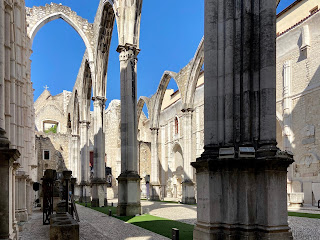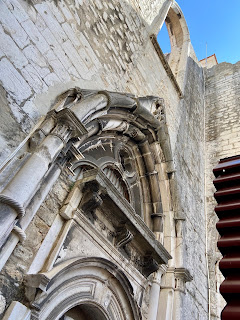The two structures we visit today are reminders of that event. The Convento e Igreja da Ordem do Carmo is a ruined gothic church that has been repurposed as an archeological museum. While the Igreja de São Domingos is rebuilt from the damaged parts, the damage clearly visible. I thought these two might be able to offer lessons in perseverance, a quality in great need just now.
The vacant arches of the Carmo are visible above Praça do Rossio, and are a landmark from many of Lisbon's miradouros. It's a place we've walked around, but never inside. The structure dates from the late 1300's. The access from the historic largo is down a pair of stairs – the elements are reminiscent of the Igreja de Santa Maria da Graça in Santarém, which was built about the same time. Once inside, however, it feels more like a park than a church, with runners of astro-turf bounding the nave. In the side aisles are what appear to be pieces of the damaged building, along with other sculptural pieces: a considerable torch-finial, columns, column capitals and bases, baptismal fonts, and other architectural relics.
The arrangement makes it difficult to determine if some of the pieces survived the disaster, or were placed after. For example, the Manueline tomb that is embedded in the wall is from Santarém (is he locked on his deathbed and standing on his jailer holding the keys?). The little flier also makes it clear that many of the other pieces come from other locations. But it all looks clean and vibrant, with the shadows of the arches casting over the assembly.
The transept tells a different kind of story. To the left, there is a metal and glass museum shop. To the right there is a large statue of São João Nepomuceno, weathered by rainwater as a drowned martyr might be, holding the crucifix, and crowned with a glorious hoop-halo. In front, observing the rising saint, is a rather modern-art-looking, armless, enigmatic figure; on the front, he is flat and faceless as well.
Perhaps, like us, he is looking for a sign of better things.
From the crossing, the view back into the arches is romantic and evocative. We arrive just as the sun is pulling the shadows upward, over the sculpture garden and the east-facing wall. From São João's vantage, we can look above the gift store and see a small (recreated?) rosette, set above a partially collapsed gothic portal with its lopsided trefoil. Squeezing behind the store, we find a small trove of extra chapel parts and basins, full of expressive characters.
Where the altar should be off the transept, there is a carved-stone doorway, with cherubs and griffins. I assume this wall, along with the Manueline window above, is new infill. The composition does make a charming garden facade.
There is a kind of glass airlock, and then we access the choir space and apse. Here, there is a collection of tombs and a marvelous iron pendant with three lanterns; the morning light filling the chamber with warmth. The stone creates a wainscot, with unfinished rubble blocks above, and exposed masonry vaults in the ceiling clearly discernible.
On the backside of the church wall are three tile panels, the central arched group seems to show Saint George killing the dragon, with what might be Lisbon in flames at his feet. The rising sun beams over his sword and the reflections make it hard to read the stories, but the effect is rousing.
There are quite a few kings and queens, and as the flier tells us, most of these are also relocated from other places. For example, the tomb of Dom Fernando I, in the center of the room, is also from Santarém. On the rear, there is a lovely architectural scene with stairs, which shows life in the Lisbon hills back in the time of his reign (about the time the Carmo was built). There is a properly regal tomb for Maria Anna (of Austria), Portagallæ Regina, widow of Dom João V. The sarcophagus sits upon a pair of monumental lions, on a connecting plinth, and is topped by four angels and a crown – one of the cherubs has taken her skull.
To the right of the apse, there are two smaller chapel rooms with Portuguese artifacts, walking back in time to the Paleolithic. In the center of the first room is a block from a pillar, with griffins shown in lively relief. The chapel at the end is filled with pendant pieces and odd horned objects pierced with holes. As we were told in Evorá, some of these may be worn by those entombed in the antas found in the area around Lisbon, in this case, Azambuja.
Passing back to the chapel rooms on the left, we enter a kind of library, with additional historic pieces and busts above the book shelves. Again, on the backsides of the church walls are storybook tiles, with several scenes of frightful violence and other biblical spectacles. The uplighting provides a raking light that emphasizes the damaged relief of the stone. There are the two smaller rooms, and the larger sacristy at the end, which has been converted to a small theater, where a multi-media projection plays upon the ornamental stone arches.
Leaving the Carmo, we head down the hill, through Rossio, to São Domingos. It has a tidy baroque facade, which must date from the earthquake reconstruction, with lots of action at the very top and the portico. Curiously, the entry combines stylized Corinthian capitals and Doric triglyphs.
Inside, the space is quite large, with heavily damaged columns and arches seemingly held in relief by a featureless, mottled-pink 'smooth shell', forming a single barrel-vaulted nave. It feels almost more of a ruin than the Carmo. However, there are a good number of people seated, so it appears to be an active place of worship.
Along the walls, tiny figures are grouped on shallow shelves, exaggerating the scale of the arches. Your eyes are lead to the altar where a large cross is backlit by a cascade of yellowed, layered stone. This is set in an ornate Composite order frame, flanked by two ghostly, sculptures.
In the transept, on the right, is an imposing, spectral pietà. Above that, a small, stiff-looking Madonna enrobed in purple, sits at the base of a large, plain, dark cross, again, with that gold backlight and within an arched, 'smooth shell' niche. To the left of the pietà, a male figure in a red cloak, on a gold pedestal, appears to look up at the Madonna – I assume this is São Domingos, as he appears barefoot.
In the left transept is the figure of Christ, His Sacred Heart visible through his clothes. Above Him, in the 'smooth shell' niche, an invisibly-small Madonna and Child inside a decorative box, sits at the feet of another inky Christ figure.
Also visible in this part of the transept are burned and damaged surfaces and wall decorations. Closer inspection of these surfaces and stones reveals plaster and paper laminations, and rubble stone and brick. As an architectural viewer and enthusiast, the building does not really read as a 'normal' church structure. The parts are back together but it is an uneasy fit. The unadorned 'smooth shell' used to infill and shelter the dilapidated elements are inappropriately plastic. It doesn't 'fade away'; it competes.
Where the Carmo felt like a garden inside, this really feels like a ruin that someone forcibly attempted to make back into a church. São Domingos is the site of a series of disasters, brutal executions, the headquarters to the Inquisition. The remains of that history can only provide a veneer to frame the improperly-scaled religious objects required to make this a place of prayer and communion. It is an unsettling and somber kind of grandeur.
Nearby, there is the one unsoiled, white sculptural figure of a crowned Madonna, in prayer, atop the tree of life, above the shield of Portugal. The swirling and burnt stone ornament, and the blistered pink wall covering in the clerestory struggle to hang together.
cases: 13,306,031 global • 3,487,635 USA • 47,051 Portugal
deaths: 557,205 global • 138,424 USA • 1,668 Portugal
The US seven-day average COVID-19 cases per day is over sixty thousand (60,997). In California, Gov Newsom is re-issuing business restrictions, state-wide. Though Southern California is being hit much harder than the North, several counties in the Bay Area are badly affected, too.
In Portugal, the situation is steady, but it's not really improving either. The seven-day average is up to 376.4 new cases per day. The calamity status has been extended for the out-lying areas of Lisbon.
Georgia is a real mess; the seven day average is 3356.1 cases per day. The average has more than quadrupled (431.7-percent) in a month. Despite the data, Gov Kemp continues to take no substantive action to limit the spread of the virus.






























































No comments:
Post a Comment